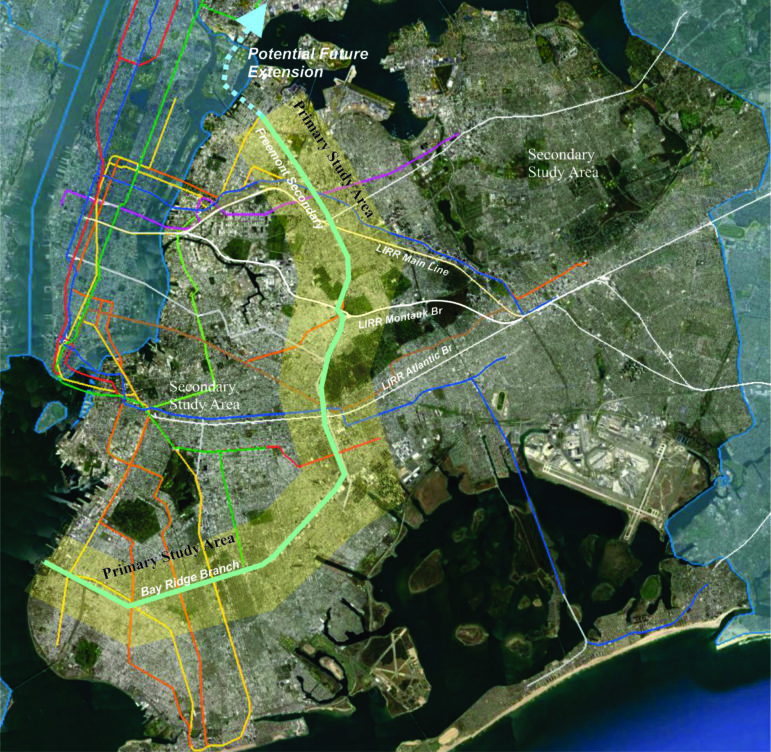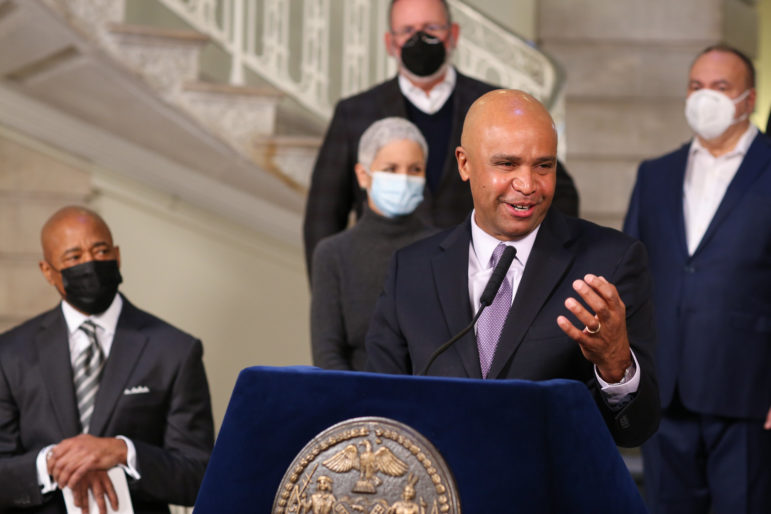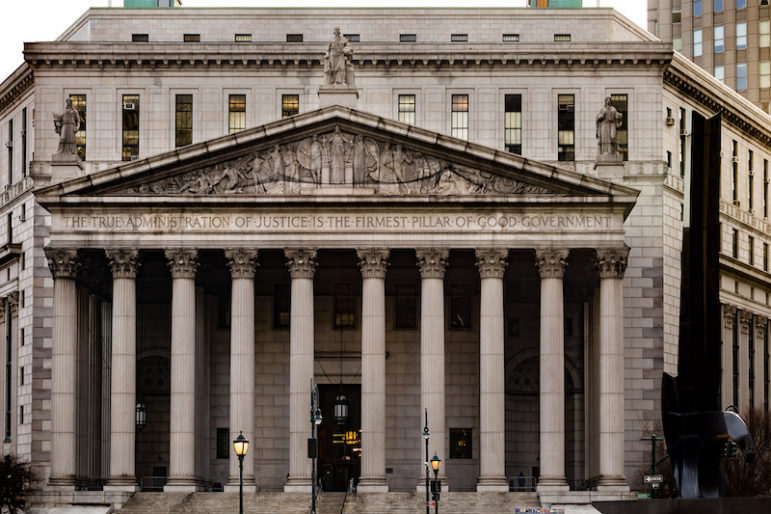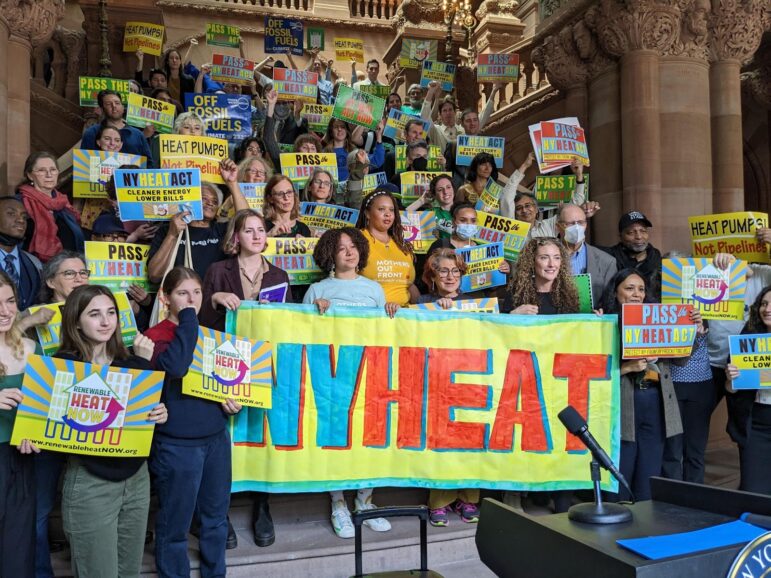
MTA
The MTA is studying the potential of adding new passenger service along this route between Brooklyn and Queens.An engineering firm launched a study this week, on behalf of the MTA, exploring the possibility of adding passenger transit service along what’s currently a freight-only rail line that runs between Brooklyn and Queens, transit officials announced Wednesday.
The study, conducted by AECOM under a $1.3 million MTA contract, would look at the potential of adding “subway, commuter rail, light rail or bus service” along the Bay Ridge Branch, a 16-mile existing freight rail line that runs from Astoria to Bay Bridge, passing through the neighborhoods of Midwood, East New York, Brownsville, Bushwick, Glendale, Middle Village and Elmhurst.
Any passenger service added on the route would run alongside existing freight service along the line, sections of which are owned by the MTA, New York & Atlantic Railway and the freight company CSX. The line could potentially connect passengers to other transit system options, including the LIRR and 19 subway lines, officials said.
“This project is hugely exciting – partly because it is based on the concept of squeezing more out of our already existing infrastructure so we don’t always have to build new subway lines from scratch,” MTA Chief Development Officer Janno Lieber said in a statement.
The proposal is one of several ideas floated in recent years to increase public transit options connecting the outer boroughs, such as Mayor Bill de Blasio’s controversial BQX Streetcar plan.
The Regional Plan Association, a research advocacy group, has for decades been pushing for a similar project called The Triboro, though their proposal would extend even further, running 24-miles total and terminating in The Bronx’s Co-Op City.
Regional Plan Association’s President President Tom Wright said the MTA’s study is a “crucial first step” to realizing the group’s vision, and for creating better commutes outside Manhattan.
“Transit service on the Bay Ridge Line would not only provide better transit service between the outer boroughs but also cut construction and acquisition costs since the rail tracks are already there,” Wright said in a statement. “This study will build on our initial concept, and evaluate cost, feasibility, among other issues, to help push the project forward.”
The MTA did not yet have a timeline for when the study will be completed.









6 thoughts on “MTA Studies Adding Passenger Service to Rail Line Linking Brooklyn and Queens”
Manhattan Borough President and future 2013 Democratic Party primary NYC Comptroller candidate Scott Stringer called for construction of a new “Triboro X” subway line. This would connect Brooklyn, Queens and The Bronx. It made a great sound bite at the time and got Stringer some free publicity. But you have to ask seven years later, just what has he done to follow up? As always, the devil is in the details. Stringer said that this would be his number one transportation priority if elected NYC Comptroller. I have seen no evidence that Stringer, since January 2014 as NYC Comptroller, continued to advocate the new Triboro “X” line as his number one transportation priority since assuming office when speaking to voters around town, as part of municipal budget negotiations or as a potential 2021 NYC candidate for Mayor.
In 2016, the Regional Planning Association updated release of an old proposal for construction of the Triboro X Bronx-Queens-Brooklyn new rail service. Just how did the RPA come up with a potential cost of $1 to $2 billion? My experiences of over 31 years in the transportation field tell me it could easily cost several billion more. Any proposed extension of the route from Bay Ridge, Brooklyn to Staten Island would require construction of a tunnel and additional station at the St. George Staten Island Ferry Terminal. This could also provide a connection to the Staten Island Rapid Transit station and system.. This additional work alone could easily cost $5 billion.
There are no dollars programmed to support any work for advancement of this project contained with the MTA’s $51 billion Five Year 2020 – 2024 Five Year Capital Plan. Don’t be surprised if the same holds true for the MTA 2020 – 204 Twenty Year Capital Needs Assessment Plan. The same is true for the upcoming new 2021 $178 billion State and $95 billion City budgets.
The New York State Department of Transportation sponsors a local planning organization known as the New York Metropolitan Transportation Council. They produce a Transportation Improvement Program which is part of the State-wide Transportation Improvement Program. Is this project listed on the TIP and or STIP? Is the project included within the New York Metropolitan Transportation Council local New York State Metropolitan Planning Organization Five Year Short Range and Twenty Year Long Range Plan for capital transportation projects?
Other than the Regional Planning Association updated briefing paper, there have been no planning feasibility studies, environmental documents or preliminary design and engineering efforts necessary to validate any basic estimates for construction costs of the “X” line. These would have to be refined as progress proceeds beyond the planning and environmental phases into real and final design efforts. Value engineering, a process used to reduce costs, would have to be used during the final design phase. Unfortunately, history has shown that estimated costs for construction usually trend upwards as projects mature toward 100% final design. Progression of final design refines the detailed scope of work necessary to support construction. The anticipated final potential cost for the “X” line would never be known until completion. Costs would be further refined by award of construction contracts followed by any unforeseen site conditions and change orders to the base contracts during the course of construction.
The proposed revised Triboro X route starting from Yankee Stadium in the Bronx connecting with Queens and terminating in Bay Ridge, Brooklyn will traverse dozens of neighborhoods impacting several hundred thousand people living nearby. How will they react to potential noise and visual impacts of a new elevated subway? There are serious legal and operational issues to be resolved with the Federal Rail Road Administration. They have regulatory jurisdiction over significant portions of the proposed route which would run adjacent to existing active freight tracks. Subway and freight trains have to coexist on the same narrow corridor.
Project costs will probably include a series of new stations with elevators and escalators. This is necessary to provide transfer capacity with 15 subway and 4 commuter rail stations that intersect along the “X” line route. (Each connecting subway or commuter rail station could easily cost from $50 to $100 million; (Imagine the costs of escalators and including elevators to be in compliance with ADA). Add to that — new track, signals, power, power substations and a hundred or more new subway cars ($2 million per car). This additional fleet would require construction of a new maintenance, operations and storage yard (several hundred million.) What community would be willing to host such a facility. There is also a potential serious conflict at the Bay Ridge, Brooklyn terminus. This is also a potential site for a connection to the proposed $10 billion Cross Harbor Freight Tunnel project.
History has told us that construction of most major new transportation system expansion projects have taken decades. There is the completion of feasibility studies, environmental reviews, planning, design, engineering, real estate acquisition, permits, procurements, budgeting, identifying and securing funding to pay for all of the above before construction can start.
(Larry Penner is a transportation historian, writer and advocate who previously worked 31 years for the United States Department of Transportation Federal Transit Administration Region 2 New York Office. This included the development, review, approval and oversight for billions in capital projects and programs for the MTA, NYC Transit, Long Island Rail Road, Metro North Rail Road, MTA Bus, NYC Department of Transportation along with 30 other transit agencies in NY & NJ).
Wow, thank you for that clarity
There is no market for a route like this. Outside of Brooklyn College the route wouldn’t serve any major destinations. Who goes from Bay Ridge to the Bronx? Very very few people. The line would have to connect to the rest of the subway system to access the yards and repair facilities. This is not a good idea.
A little history of the ‘Bay Ridge’ line, called the ‘Manhattan Beach’ branch by the LIRR –
http://arrts-arrchives.com/mbbr2.html
The sheer cost of such an undertaking as this, while other more pressing capital projects (Gateway) wait for funds, means this will end up as an SBS line. It’s easy and much less expensive to update and modify bus routes as demand warrants.
I returning/seeking full time employment with NYC WorkForce1 , Im in Bk, Im often given job openings in the Bx/Qns not many in BK + Ive met different store employees here in ENY B’klyn who live in the Bx. So perhaps times have changed? ✌🏽✌🏼✌🏾✌🏻
This rail link is vital to move vast amounts of people through Queens and Brooklyn to the Bronx and the northern sections of the Bronx. Also access to downtown Brooklyn is very important. Building a new line from downtown Brooklyn would change the dynamics of travel through the congested Manhattan Borough and reduce travel time. Getting this line built and making it big enough to include express and local service could be a problem. How much and how long will this take. Remember how long the Second Avenue subway took.